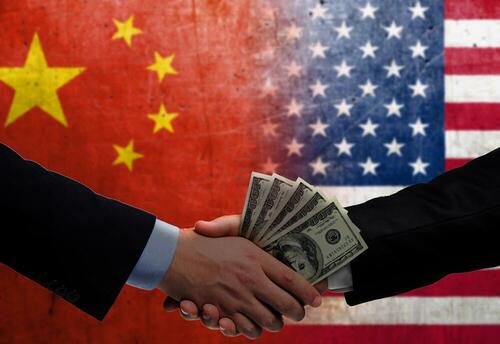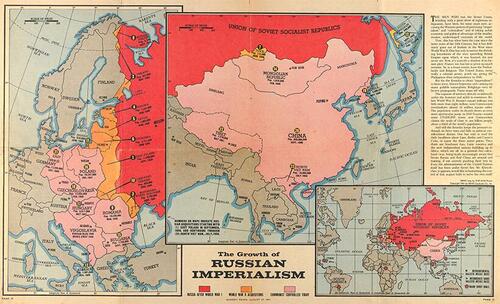Authored by Peter Schweizer via The Gatestone Institute,
-
[Elite capture] is a crucial tool of [China’s] success. The idea is simple enough: by tempting another country’s elite with money, access and favors, you move them to see their interests and China’s interests as intertwined or even the same.
-
[Each] of the individuals we discuss would deny their role in helping China gain access to American capital markets, American military and surveillance technology, or American policy making. Each will say they are merely pursuing business opportunities that the Chinese market has offered them, as any goods capitalist should. They may argue the companies they run are truly international…
-
Ray Dalio, who wrote in his 2017 book, which bears the title Principles, of his “personal hero,” Wang Qishan. “Every time I speak with Wang,” Dalio swooned, “I feel like I get closer to cracking the unifying code that unlocks the laws of the universe.” Wang is the second most powerful man in the Chinese Communist Party and known as Xi’s enforcer. The Economist called him “the most feared man in China.” But not to Dalio. Readers learn, on the very next page of that book that at the same time Dalio was trying to start a new hedge fund in China.
-
Nor are they all as obsequious about it as Facebook’s Mark Zuckerberg.
-
Almost everything [Apple] sells is manufactured in China, and the iPhone has more than 23 percent of the market for phones in China. Apple has repeatedly been accused of benefiting from the forced labor of Chinese Uyghurs, which the company denies.
-
As the muckraker and novelist Upton Sinclair wrote, “It is difficult to get a man to understand something when his salary depends on his not understanding it.”
While researching how Americans having been getting rich by helping the Chinese Communist Party achieve its outspoken aim of replacing the US as the “world’s No.1 power,” I came across the phrase “elite capture” — their term to describe the actions of influential people in the US towards China.

“Elite capture” can refer to different things, but to the Chinese Communist Party, China’s intelligence apparatus, or those involved in quasi-private business ventures, it is a crucial tool of their success. The idea is simple enough: by tempting another country’s elite with money, access and favors, you move them to see their interests and China’s interests as intertwined or even the same.
The Chinese are not subtle about this, and they barely try to hide it. They practice it around the world, most notably in Africa in pursuit of their Belt and Road Initiative. But elites in Western democracies have proved to be a soft touch, particularly among non-governmental elites.
“Red Handed: How American Elites are Helping China Win,” my latest book, centers on this truth and explores how elites in academia, high-finance, sports and entertainment, and the technology sector became apologists for China’s deplorable human rights record, industrial and military espionage, and increasingly aggressive behavior.
What separates this from ordinary diplomacy or even the time-honored business slogan that “the customer is always right” is the power wielded by those who succumb to the temptation. The book investigates the public activities and statements of some of the most powerful people in the US. From the world of Silicon Valley, we explore Mark Zuckerberg of Facebook, Tim Cook of Apple, and Bill Gates of Microsoft. From the world of Wall Street, we looked at Ray Dalio of Bridgewater, the largest hedge-fund investment company in the world, and Larry Fink of BlackRock. From academia we explored the actions of Harvard and Yale universities. We surveyed the relationship histories of the Bush family, the Trudeau family of Canada, the Pelosi family, and of course, the Biden family.
Yet, the news each day is full of still other examples. The way China has co-opted all these people and institutions – and others besides – is alarmingly similar, straightforward, and not hard to piece together. In 30 years of investigative reporting, I am used to having to dig through endless layers of shell corporations, intermediaries, bank records and tax filings to reveal these connections. Yet, the connections between the people and institutions we reviewed, and the Chinese government, fairly glowed on the page once we determined to look at the mechanics of corruption through the lens of Chinese capture of American elites. This is one reason I have said this is the scariest investigation I have ever done.
Pressed to the wall, each of the individuals we discuss would deny their role in helping China gain access to American capital markets, American military and surveillance technology, or American policy making. Each will say they are merely pursuing business opportunities that the Chinese market has offered them, as any goods capitalist should. They may argue the companies they run are truly international corporations and, as such, obligated to take as neutral a stance on American foreign policy as possible.
And they are not fully wrong about that.
Not all of them are as brazen about it as the Sri Lanka-born Chamath Palihapitiya, a billionaire venture capitalist and investor who in an interview last week waved away the issue of China’s genocide against its own Uyghur citizens with the dismissive “nobody cares.”
Nor are they all as obsequious about it as Facebook’s Mark Zuckerberg. At a 2015 state dinner at the White House for visiting Chinese President Xi Jinping, the third-richest man in the world squired his ethnically Chinese, seven-months-pregnant wife over to be introduced to Xi and immediately made a strange request. Would Xi give their unborn child his Chinese name? The communist dictator was shocked by the request and politely declined, explaining it would be “too great a responsibility” to give to a total stranger.
Nor are they as star-struck about it as Ray Dalio, who wrote in his 2017 book, which bears the title Principles, of his “personal hero,” Wang Qishan. “Every time I speak with Wang,” Dalio swooned, “I feel like I get closer to cracking the unifying code that unlocks the laws of the universe.” Wang is the second most powerful man in the Chinese Communist Party and known as Xi’s enforcer. The Economist called him “the most feared man in China.” But not to Dalio. Readers learn, on the very next page of that book that at the same time Dalio was trying to start a new hedge fund in China.
Apple Computers is another great example. Almost everything the company sells is manufactured in China, and the iPhone has more than 23 percent of the market for phones in China. Apple has repeatedly been accused of benefiting from the forced labor of Chinese Uyghurs, which the company denies. But, as a tech investor told Vanity Fair recently, “If you’re Apple and you’ve spent 20 years building infrastructure in China, you can’t just press a button and move your entire infrastructure to India,” adding, “Rebuilding your supply chain takes 10 to 15 years. Right now, I just don’t think they have a choice.”
Of course, Apple’s CEO, Tim Cook, was present at an exclusive meeting at Microsoft’s headquarters in Seattle, where tech titans met Xi even before that 2015 state dinner. When Xi entered the room, a thunderstruck Cook turned to a colleague and said, “Did you feel the room shake?”
For others it happens similarly with commercial opportunities. No one should have been shocked by basketball player LeBron James’s upbraiding another NBA team’s general manager for tweeting about China’s repression of democratic protests in Hong Kong. James earns millions royalties on jerseys and other items bearing his name and likeness in China, but is apparently also expert on foreign affairs, scolding the Houston Rockets’ then-GM Daryl Morey as “either misinformed or not really educated on the situation” regarding Chinese repression of dissent in the territory.
Yet the Chinese communists are not absolutists about this. There is a common phrase in Mandarin that roughly translates: “A lot of help, with a little badmouth.” The phrase captures that the practical Chinese know their friends will have to criticize China’s actions from time to time. But so long as those friends are advancing China’s interests on the important things, they will deign to overlook that.
House Speaker Nancy Pelosi was a harsh critic of China’s human rights abuses. In her first term in Congress, she found herself in Tiananmen Square in 1991 and bravely unfurled a banner inscribed, “To those who died for Democracy in China.” Furious Chinese police seized the banner. “I started running,” Pelosi recalled. “And my colleagues, some of them, got a little roughed up. The press got treated worse because they had cameras, and they were detained.”
She too has recently evolved. And her husband, Paul, has since made millions of dollars in deals with China as a partner investor in Matthews International Capital Management, a pioneer in the Chinese investment market, and through his other ventures. She has, for two years now, blocked efforts by Congress to investigate the origins of the COVID virus. With much of the evidence pointing to the possibility of a lab leak of the virus in Wuhan, Pelosi ordered the Democrats in Congress not to cooperate with any efforts to investigate the matter.
The behavior, statements and actions of these and many other people we discuss at length in the book, certainly suggest the intertwining of their interests with China’s interests. And those interests are thick enough to block out the humanitarian and national security concerns that China’s rise is built upon.
As the muckraker and novelist Upton Sinclair wrote, “It is difficult to get a man to understand something when his salary depends on his not understanding it.”













